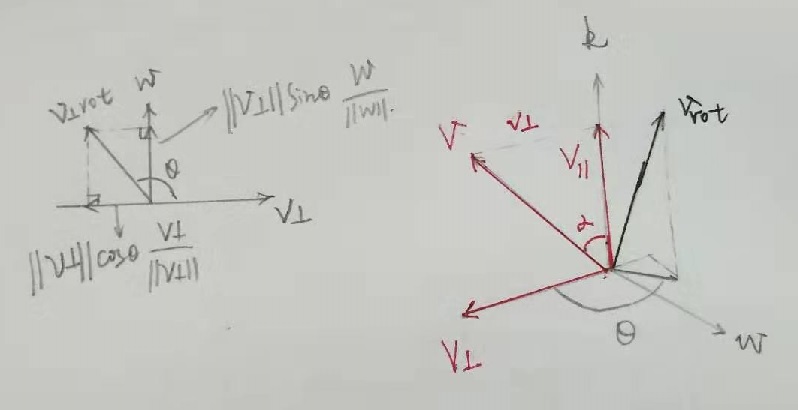在三维空间中,给定一固定旋转轴,任意初始向量绕旋转轴旋转任意角度,可表示为  ,其中,v 表示旋转前向量,
,其中,v 表示旋转前向量, 表示旋转后向量,R 表示旋转矩阵,该矩阵参数与固定旋转轴坐标,旋转角度有关。下面使用图示推导旋转矩阵 R:
表示旋转后向量,R 表示旋转矩阵,该矩阵参数与固定旋转轴坐标,旋转角度有关。下面使用图示推导旋转矩阵 R:

如上图所示,单位向量  为固定旋转轴,原向量 v 旋转
为固定旋转轴,原向量 v 旋转  后为
后为  ;
;
分解原向量  ,向量 v 与向量 k(或者
,向量 v 与向量 k(或者  ) 的夹角为
) 的夹角为  ,该值已知;
,该值已知;
向量  构成直角三角形,则有:
构成直角三角形,则有:  ,
, ;
;
向量叉乘  ,其方向垂直于
,其方向垂直于  构成的平面,w 的模长为
构成的平面,w 的模长为  ,则有
,则有  ,且两向量正交;
,且两向量正交;
以上向量  构成三维空间已知正交向量基,
构成三维空间已知正交向量基, 可表示:
可表示: ,在
,在  向量构成平面上,
向量构成平面上, 旋转
旋转  后为:
后为:
 ,
,  ,由于
,由于  ,进一步化简为:
,进一步化简为:
 ;
;
定义向量  ,其方向与
,其方向与  平行,其模长为
平行,其模长为  ,则
,则  ;
;
引入向量  的叉积矩阵
的叉积矩阵  ,叉积运算可转换为矩阵运算
,叉积运算可转换为矩阵运算  ;
;
改写  线性组合
线性组合  ,引入叉积矩阵 K得:
,引入叉积矩阵 K得:
 ,
,
则旋转矩阵  。
。
以下给出代码实现:
1 void GetRotateMatrix(Matrix<float>& Q, Vector<float>& axis, float theta)
2 {
3 // 使用罗德里格斯公式(Rodriguez formula)
4
5 // 构造单位向量
6 float len = sqrt(axis.data[0] * axis.data[0] +
7 axis.data[1] * axis.data[1] + axis.data[2] * axis.data[2]);
8 axis.data[0] = axis.data[0] / len;
9 axis.data[1] = axis.data[1] / len;
10 axis.data[2] = axis.data[2] / len;
11
12 // 构造叉积矩阵K
13 Matrix<float> K(3, 3);
14 *(K.data + 0) = 0.;
15 *(K.data + 1) = -axis.data[2];
16 *(K.data + 2) = axis.data[1];
17 *(K.data + K.step * 1 + 0) = axis.data[2];
18 *(K.data + K.step * 1 + 1) = 0.;
19 *(K.data + K.step * 1 + 2) = -axis.data[0];
20 *(K.data + K.step * 2 + 0) = -axis.data[1];
21 *(K.data + K.step * 2 + 1) = axis.data[0];
22 *(K.data + K.step * 2 + 2) = 0.;
23
24 // 求K^2
25 Matrix<float> K_Temp; K_Temp = K;
26 Matrix<float> K_2; K_2 = K;
27 K_2.Multiply(K, K_Temp);
28
29 // 求变换矩阵Q(Q = I + (1 - cos(theta))K^2 + sin(theta)K)
30 K.ScalarMultiply(sin(theta));
31 K_2.ScalarMultiply(1. - cos(theta));
32 K_Temp.SetIdentity();
33
34 Q.SetZero();
35 Q.Add(K);
36 Q.Add(K_2);
37 Q.Add(K_Temp);
38
39 // 得到旋转矩阵后,使用旋转矩阵Q将任意点沿axis轴旋转theta幅度
40 }
1 template<typename TYPE> struct Matrix
2 {
3 int rows;
4 int cols;
5 int step;
6
7 TYPE* data;
8
9 Matrix()
10 {
11 rows = cols = step = 0;
12 data = 0;
13 }
14
15 Matrix(int _rows, int _cols)
16 {
17 rows = _rows;
18 cols = _cols;
19 step = _cols;
20 data = (TYPE*)malloc(sizeof(TYPE) * rows * cols);
21 memset(data, 0, sizeof(TYPE) * rows * cols);
22 }
23
24 ~Matrix()
25 {
26 if(!data) free(data);
27 }
28
29 void operator = (Matrix<TYPE>& _mat)
30 {
31 rows = _mat.rows;
32 cols = _mat.cols;
33 step = _mat.step;
34
35 if(data) free(data);
36 data = (TYPE*)malloc(sizeof(TYPE) * rows * cols);
37 memcpy(data, _mat.data, sizeof(TYPE) * rows * cols);
38 }
39
40 bool Add(Matrix<TYPE>& src1)
41 {
42 if (src1.rows != rows || src1.cols != cols)
43 return false;
44
45 for (int r = 0; r < rows; ++r)
46 for (int c = 0; c < cols; ++c)
47 {
48 *(data + r * step + c) += *(src1.data + r * src1.step + c);
49 }
50 }
51
52 void ScalarMultiply(double scalar)
53 {
54 for (int r = 0; r < rows; ++r)
55 for (int c = 0; c < cols; ++c)
56 {
57 *(data + r * step + c) = *(data + r * step + c) * scalar;
58 }
59 }
60
61 void SetZero()
62 {
63 memset(data, 0, sizeof(TYPE) * rows * cols);
64 }
65
66 void SetIdentity()
67 {
68 memset(data, 0, sizeof(TYPE) * rows * cols);
69
70 int m = cols < rows ? cols : rows;
71 for(int i = 0; i < m; ++i)
72 *(data + i * step + i) = 1;
73 }
74
75 void ExchangeRows(int i, int j)
76 {
77 if(i < rows && j < rows)
78 {
79 TYPE* temp = (TYPE*)malloc(sizeof(TYPE) * rows);
80 memcpy(temp, data + i * step, sizeof(TYPE) * rows);
81 memcpy(data + i * step , data + j * step, sizeof(TYPE) * rows);
82 memcpy(data + j * step, temp, sizeof(TYPE) * rows);
83 free(temp);
84 }
85 }
86
87 bool Transpose(Matrix<TYPE>& dst)
88 {
89 if(rows != dst.cols || cols != dst.rows || !data || !dst.data)
90 return false;
91
92 for(int r = 0; r < rows; ++r)
93 {
94 TYPE* src_data = data + r * step;
95 TYPE* dst_data = dst.data + r;
96
97 for(int c = 0; c < cols; ++c)
98 {
99 *dst_data = *src_data;
100
101 ++src_data;
102 dst_data += dst.step;
103 }
104 }
105
106 return true;
107 }
108
109
110 bool Multiply(Matrix<TYPE>& src1, Matrix<TYPE>& src2)
111 {
112 if(src1.cols != src2.rows || rows != src1.rows || cols != src2.cols)
113 return false;
114
115 for(int r = 0; r < rows; ++r)
116 {
117 for(int c = 0; c < cols; ++c)
118 {
119 double value = 0.;
120 for (int i = 0; i < src1.cols; ++i)
121 {
122 value += (*(src1.data + r * src1.step + i)) * (*(src2.data + i * src2.step + c));
123 }
124 *(data + r * step + c) = value;
125 }
126 }
127
128 return true;
129
130 }
131
132 };
来源:https://www.cnblogs.com/luofeiju/p/12016761.html